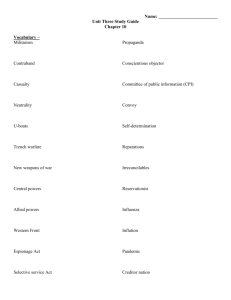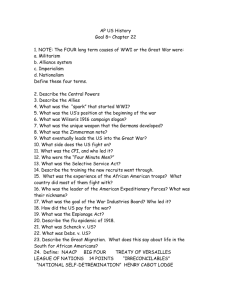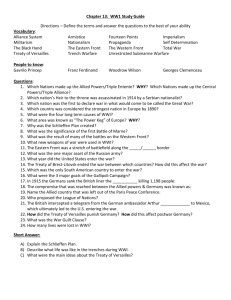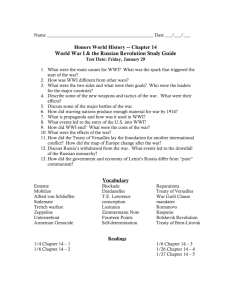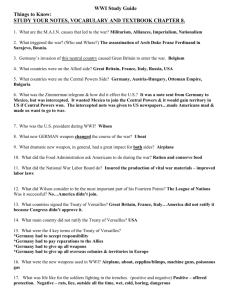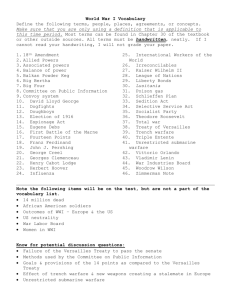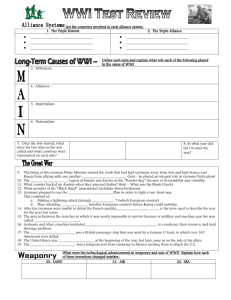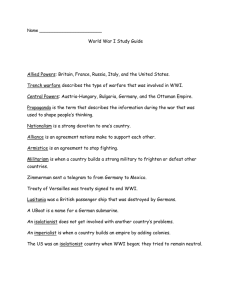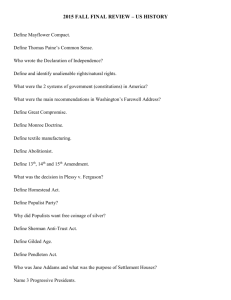The U.S. History Review
advertisement
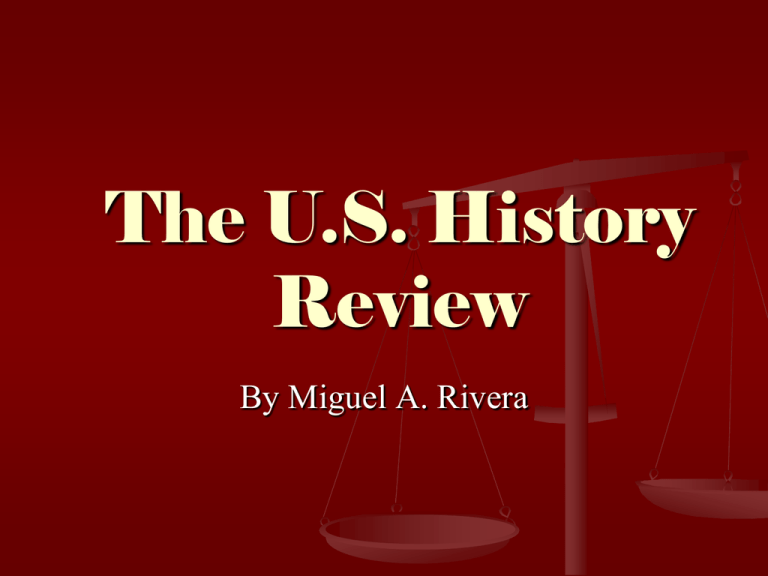
The U.S. History Review By Miguel A. Rivera Section 10 World War I What are some characteristics of the era of World War I? Activity – World War I Gather as much information as you possibly can about the World War I in your group ½ picked to rotate will change seats every 2 ½ minutes, 2 minutes, and 1 ½ minutes after having brainstormed what you know We will come together as a class and figure out what you’ve put down. World War I Nationalism (Intense pride in one’s homeland, and self-determination – the idea that nations should have their own country and government) was growing in Europe The U.S. tries to stay out of the issues in Europe (neutrality) but is eventually made to get into the war Allies include France, Britain, Russia, and eventually, the U.S. Central Powers include Germany, the Ottoman Empire and Austria Hungary World War I New methods of fighting in war include trench warfare and unrestricted submarine warfare The U.S. uses a draft for the first time after having created the Selective Service Act, which forces young men to register with selective service by law U.S. and allies win and force Germany to take responsibility for everything in the Treaty of Versailles 6 months after the armistice (or cease-fire) is called. World War I 1914 World War I starts as a result of rising tensions in Europe and the shooting of Archduke Franz Ferdinand World War I 1917 U.S. enters World War I by declaring war on Germany World War I 1918 World War I ends World War I 1919 Treaty of Versailles puts Germany in to major debt Lusitania German U-boats, or submarines start to be used in an effort to go around British Navy blockades. Germany threatens to sink any ship that enters water around Britain. Attacking civilian ships was in direct violation of international treaty. Germans hit the Lusitania, a British passenger ship and kills 1200 passengers, 128 of which were Americans. Zimmerman Telegram German official Arthur Zimmerman, cabled the German ambassador to Mexico and proposed that Mexico ally itself with Germany Mexico would regain the territory previously lost to the U.S. Intercepted by British intelligence Leaked to U.S. newspapers. Feb. 1917- Germany goes to unrestricted warfare and sinks 4 U.S. merchant ships. U.S. declares war on Germany on April 6, 1917. Trench Warfare Both sides build elaborate holes where the fighting is pretty much static No movement forward unless you’re going to “no man’s land” between trenches where no man stays alive Used when style of fighting (because of weapons changed) but there was nothing (in terms of machines) to keep moving forward Great Migration African Americans gained wartime employment – 300,000 to 500,000 went North Mexicans moved north and provide labor for farmers and ranchers as well as manufacturing jobs in cities, still facing discrimination and hostility because of race League of Nations International organization meant to improve relationships between countries based on disarming, prevention of war, diplomacy, negotiation, and settling disputes between countries Resulted from the Treaty of Versailles, which ended World War I Treaty of Versailles Treaty that ended World War I based on the concept that Germany had to accept full responsibility for the war and pay reparations to the Allies. This put Germany into great financial debt. Wilson’s 14 Points Speech given by Woodrow Wilson at end of WWI which dealt with diplomacy and the development of the League of Nations Aimed to create a less harsh punishment for Germany, but only 4 of the 14 points were ever actually implemented Selective Service Act Federal law that authorized the president to create a volunteer infantry division All men between the ages of 21 and 30 (later 18 and 45) had to register with Selective Service and might be drafted to participate in the war Espionage and Sedition Act Federal law that made it illegal for any person to interfere with military plans of a the U.S. or provide any information to another country that might be the U.S.’s enemy WWI – Who’s this guy? WWI – Who’s this guy? – Woodrow Wilson President of the U.S. during World War I who wanted to remain neutral but was essentially forced to enter the war as a result of Germany’s acts of aggression. Developed the 14 Points which eventually led to the League of Nations WWI – Who’s this guy? WWI – Who’s this guy? – Archduke Franz Ferdinand June 1914 – Heir to AustroHungarian throne was killed by a Bosnian revolutionary, set off World War I WWI – Who’s this guy? WWI – Who’s this guy? – General John J. Pershing Highest ranking general ever (alive, because George Washington was dead when he received the rank) – General of the Armies General during World War I Mentor to great generals such as George Marshall, Dwight D. Eisenhower, Omar Bradley, and George S. Patton, all generals during World War II.

